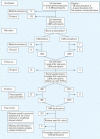A randomized controlled trial assessing infectious disease risks from bathing in fresh recreational waters in relation to the concentration of Escherichia coli, intestinal enterococci, Clostridium perfringens, and somatic coliphages
- PMID: 16451859
- PMCID: PMC1367836
- DOI: 10.1289/ehp.8115
A randomized controlled trial assessing infectious disease risks from bathing in fresh recreational waters in relation to the concentration of Escherichia coli, intestinal enterococci, Clostridium perfringens, and somatic coliphages
Abstract
We performed epidemiologic studies at public freshwater bathing sites in Germany to provide a better scientific basis for the definition of recreational water quality standards. A total of 2,196 participants were recruited from the local population and randomized into bathers and nonbathers. Bathers were exposed for 10 min and had to immerse their head at least three times. Water samples for microbiological analysis were collected at 20-min intervals. Unbiased concentration-response effects with no-observed-adverse-effect levels (NOAELs) were demonstrated for three different definitions of gastroenteritis and four fecal indicator organisms. Relative risks for bathing in waters with levels above NOAELs compared with nonbathing ranged from 1.8 (95% CI, 1.2-2.6) to 4.6 (95% CI, 2.1-10.1), depending on the definition of gastroenteritis. The effect of swallowing water provided additional evidence for true dose-response relationships. Based on the NOAELs, the following guide values for water quality are suggested: 100 Escherichia coli, 25 intestinal enterococci, 10 somatic coliphages, or 10 Clostridium perfringens per 100 mL. Recreational water quality standards are intended to protect the health of those consumers who are not already immune or resistant to pathogens that may be associated with indicator organisms. In contrast to current World Health Organization recommendations, we concluded that standards should be based on rates of compliance with NOAELs rather than on attributable risks determined above NOAELs, because these risks depend mainly on the unpredictable susceptibility of the cohorts. Although in theory there is no threshold in real concentration-response relationships, we demonstrated that a NOAEL approach would be a more robust and practical solution to the complex problem of setting standards.
Figures



References
-
- Cabelli V. 1983. Health Effects Criteria for Marine Recreational Waters. U.S. EPA Report EPA-600/1-80-031. Cincinnati, OH:U.S. Environmental Protection Agency.
-
- CEC 2002. Proposal for a Directive of the European Parliament and of the Council Concerning the Quality of Bathing Water. Brussels:Commission of the European Communities. Available: http://europa.eu.int/eur-lex/en/com/pdf/2002/com2002_0581en01.pdf [accessed 1 August 2004].
-
- Contreras-Coll N, Lucena F, Mooijman K, Havelaar A, Pierz V, Boque M, et al. Occurrence and levels of indicator bacteriophages in bathing waters throughout Europe. Water Res. 2002;36:4963–4974. - PubMed
-
- Council of the European Communities. Council Directive 76/160/EEC of 8 December 1975 Concerning the Quality of Bathing Water. Off J Eur Commun L. 1976;031:1–7.
Publication types
MeSH terms
LinkOut - more resources
Full Text Sources
Medical

